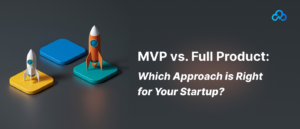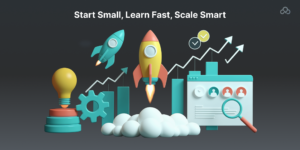MVP vs. Full Product: Which Approach is Right for Your Startup?

Startups move fast. Too fast, sometimes. You’ve got investors waiting, early users watching, and a team ready to build. It’s tempting to push for a fully polished product right out of the gate, stacked with every feature you can imagine. But that pressure to go big? It can backfire. Especially when you’re not sure if you’re solving the right problem yet. For early-stage founders, the real question isn’t “how quickly can we launch everything?” It’s “what’s the smallest version we can build that still teaches us something useful?” That’s the whole idea behind MVP vs. full product. And understanding the difference could be the most important thing you do before you start development. In this guide, we’ll compare both approaches head-to-head. We’ll show where MVP agile development excels, when a full product might be justified, and how the wrong call early on can cost you time, budget, and momentum later.
What Is an MVP?
Let’s clear something up, an MVP isn’t a prototype. And it’s not a placeholder either. A Minimum Viable Product, or MVP, is a stripped-down but functional version of your product. It does one thing well enough that real users can test it, give feedback, and help you figure out if you’re on the right track.
That’s the difference. With mvp agile development, the goal isn’t perfection, it’s progress. You don’t need to ship five features. You need one feature that gives you answers. Then you build again, smarter this time.
This build-measure-learn cycle is the foundation of any serious MVP agile development team. It’s iterative, fast, and grounded in actual user behavior, not guesses.
Key MVP agile principles:
-
Don’t guess, ship and learn
-
Talk to users early, not after launch
-
Prioritize only what moves the needle
-
Plan to rebuild, it’s part of the process
Quick case in point: Before Dropbox became a billion-dollar platform, they didn’t even build a working app. They launched with a short demo video. Just that. No product. But it worked, they got thousands of signups and immediate validation, without writing a single line of backend code.
Today, startups that work with an experienced mvp development team can roll out testable products in 4–6 weeks. Not perfect. But enough to prove whether your idea deserves a bigger build.
What Is a Full Product?
On the other side of the spectrum, you’ve got the full product approach. This is when you build out every major feature, polish the UI, and aim to launch something that feels complete from day one.
It sounds appealing, especially when you’re trying to stand out in a crowded market. But while it might feel like the “real” version of your idea, it comes with more risk than most startups can afford early on.
Whereas MVP agile development thrives on speed and learning, full product builds tend to assume you’ve already validated the idea, nailed your market fit, and are confident about what users want.
That’s rarely the case in the first six months of a startup.
When does a full product make sense?
-
You’ve already tested an MVP and gathered strong feedback
-
Your business operates in a regulated industry where minimal functionality won’t work (e.g., fintech, healthtech)
-
You’re building internal tools for known users or use cases
-
You’ve secured funding and have a longer runway
But even then, most teams benefit from staging their full product across phases, starting with MVP foundations, then layering more features once the core value is proven.
MVP vs. Full Product: Side-by-Side
Let’s break it down in plain terms.
|
Aspect |
MVP Approach |
Full Product Approach |
|
Time to Market |
4–6 weeks with a lean MVP development team |
3–6+ months, depending on complexity |
|
Cost |
Lower upfront investment |
Higher upfront (dev, design, QA, etc.) |
|
Risk Profile |
Low – agile and testable |
High – assumptions locked in early |
|
Flexibility |
Very high – rapid iteration cycles |
Low – difficult to pivot after launch |
|
Focus |
Validation and learning |
Feature completeness and market readiness |
|
Ideal When… |
The idea is new or uncertain |
Demand is clear and use case is already proven |
Transitioning from MVP to full product later is not just possible, it’s the standard playbook. That’s why custom MVP development often includes scalable architecture planning from day one.
When to Choose MVP Agile Development
Let’s be clear, MVP agile development isn’t just for startups with tight budgets. It’s for smart teams who want to reduce guesswork and maximize learning before going all in.
Here’s when MVP is the right call:
- You’re still testing product-market fit.
No matter how strong the idea sounds, you haven’t proven it until real users engage.
- Speed matters more than polish.
Whether you’re racing a competitor or trying to secure early funding, launching fast often beats launching big.
- You’re working in a new category.
If the market is unproven, building lean helps you avoid wasting resources on the wrong features.
- You value learning over assumption.
This one’s key. MVPs give you the data you need to decide what should come next, not just what looks good on a roadmap.
Working with a focused mvp development team ensures your sprints are tightly scoped and feedback-driven from day one.
When a Full Product Build Is the Better Option
Of course, there are cases where skipping the MVP agile development makes sense.
If your user base already expects full functionality, say, in enterprise SaaS, or if you’ve built similar products in the past and the market is validated, then moving directly into a full product roadmap can be the right move.
In these scenarios, you still benefit from involving a skilled mvp software development company to plan your architecture, break your release into logical phases, and avoid building too much too soon.
After all, just because you’re building more doesn’t mean you should stop learning.
Role of MVP Developers in Strategic Planning
It’s easy to think of MVP developers as just coders. But experienced teams do a lot more than write functions, they shape product thinking.
Here’s how a good mvp development team helps beyond code:
- Scoping: They help you define what’s truly essential for the first release
- Prioritization: They know which features give the most insight early
- Validation planning: They set up feedback loops, tracking, and analytics from day one
- Flexibility: They architect systems that won’t break when you grow
The best custom MVP development teams don’t just build for today. They build for what comes after launch, and they do it without bloating the product too early.
Technical FAQs
Q1: What’s the biggest risk of building a full product first?
You might build features no one needs. Without early validation, there’s a risk of spending months on something the market doesn’t want.
Q2: Can an MVP evolve into a full product?
Absolutely. Most startups build out the full product after launching an MVP. That’s why scalable MVP architecture is so important early on.
Q3: How long does MVP agile development usually take?
On average, 4–8 weeks. It depends on complexity and the capabilities of your mvp development team.
Q4: What happens after the MVP is released?
That’s when the real learning starts. You collect data, iterate, and refine the product. A good mvp software development company helps with this post-launch phase too.
Start Small, Learn Fast, Scale Smart

Every startup dreams of launching big. But the smartest ones? They start small, on purpose.
MVP agile development helps you learn faster, waste less, and build something people actually want. It gives you the space to test your assumptions before committing too much time, money, or code.
A full product might sound more impressive. But without validation, it’s just a polished guess.
So if you’re early in your journey, ask yourself: Do we need all the features, or just enough to prove we’re building the right thing?
Chances are, your MVP will tell you what to build next, if you give it the chance.
Do you like to read more educational content? Read our blogs at Cloudastra Technologies or contact us for business enquiry at Cloudastra Contact Us